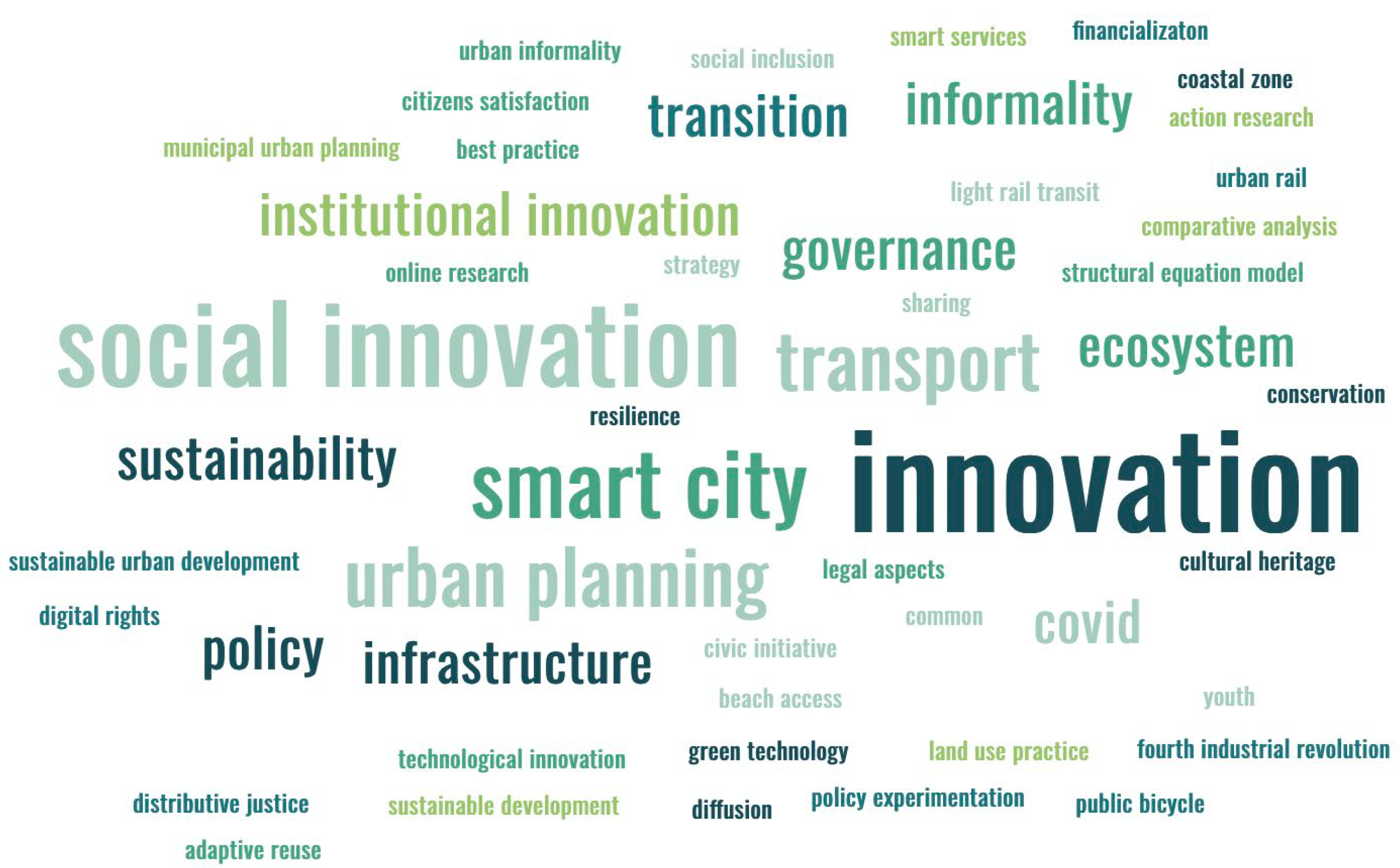Social Innovation in Sustainable Urban Development
Funding
Institutional Review Board Statement
Informed Consent Statement
Conflicts of Interest
References
- Edwards-Schachter, M.; Wallace, M.L. Shaken, but not stirred: Sixty years of defining social innovation. Technol. Forecast. Soc. Chang. 2017, 119, 64–79. [Google Scholar] [CrossRef] [Green Version]
- Avelino, F.; Wittmayer, J.M.; Pel, B.; Weaver, P.; Dumitru, A.; Haxeltine, A.; Kemp, R.; Jørgensen, M.S.; Bauler, T.; Ruijsink, S.; et al. Transformative social innovation and (dis)empowerment. Technol. Forecast. Soc. Chang. 2019, 145, 195–206. [Google Scholar] [CrossRef]
- Angelidou, M.; Psaltoglou, A. An empirical investigation of social innovation initiatives for sustainable urban development. Sustain. Cities Soc. 2017, 33, 113–125. [Google Scholar] [CrossRef]
- Fava, F. Commoning adaptive heritage reuse as a driver of social innovation: Naples and the Scugnizzo Liberato case study. Sustainability 2022, 14, 191. [Google Scholar] [CrossRef]
- BEPA Bureau of European Policy Advisers. Empowering People, Driving Change: Social Innovation in the European Union; Publications Office of the European Union: Luxembourg, 2010. [Google Scholar]
- Sabato, S.; Vanhercke, B.; Verschraegen, G. Connecting entrepreneurship with policy experimentation? The EU framework for social innovation. Innov. Eur. J. Soc. Sci. Res. 2017, 30, 147–167. [Google Scholar] [CrossRef]
- Schumpeter, J.A. Business Cycles: A Theoretical, Historical and Statistical Analysis of the Capitalist Process; McGraw-Hill: New York, NY, USA, 1939. [Google Scholar]
- Mieg, H.A. Sustainability and innovation in urban development: Concept and case. Sustain. Dev. 2010, 20, 251–263. [Google Scholar] [CrossRef]
- Mieg, H.A. Book Introduction. In Institutional and Social Innovation for Sustainable Urban Development; Mieg, H.A., Töpfer, K., Eds.; Earthscan: London, UK, 2013; pp. 1–21. [Google Scholar]
- Goldfrank, B. Participatory budgeting and urban sustainability: Reviewing lessons from South America. In Institutional and Social Innovation for Sustainable Urban Development; Mieg, H.A., Töpfer, K., Eds.; Earthscan: London, UK, 2013; pp. 57–71. [Google Scholar]
- Oh, J.; Seo, M. Measuring citizens-centric smart city: Development and validation of ex-post evaluation framework. Sustainability 2021, 13, 11497. [Google Scholar] [CrossRef]
- Calzada, I. The right to have digital rights in smart cities. Sustainability 2021, 13, 11438. [Google Scholar] [CrossRef]
- Tan, H.; Du, S. The governance challenge within socio-technical transition processes: Public bicycles and smartphone-based bicycles in Guangzhou, China. Sustainability 2021, 13, 9447. [Google Scholar] [CrossRef]
- Szemzö, H.; Mosquera, J.; Polyák, L.; Hayes, L. Flexibility and adaptation: Creating a strategy for resilience. Sustainability 2022, 14, 2688. [Google Scholar] [CrossRef]
- Peter, C. Social innovation for sustainable urban developmental transitions in Sub-Saharan Africa: Leveraging economic ecosystems and the entrepreneurial state. Sustainability 2021, 13, 7360. [Google Scholar] [CrossRef]
- Huang, Y.; Xue, D.; Huang, G. Economic development, informal land-use practices and institutional change in Dongguan, China. Sustainability 2021, 13, 2249. [Google Scholar] [CrossRef]
- Sekasi, J.; Martens, M.L. Assessing the contributions of urban light rail transit to the sustainable development of Addis Ababa. Sustainability 2021, 13, 5667. [Google Scholar] [CrossRef]
- Grafe, F.-J.; Mieg, H.A. Precaution and innovation in the context of wastewater regulation: An examination of financial innovation in London and Milan. Sustainability 2021, 13, 9130. [Google Scholar] [CrossRef]
- Morgado, S. Urban rehabilitation, social innovation, and new working spaces in Lisbon. Sustainability 2021, 13, 11925. [Google Scholar] [CrossRef]
- Erdogan, E.; Flynn, P.; Nasya, B.; Paabort, H.; Lendzhova, V. NEET rural–urban ecosystems: The role of urban social innovation diffusion in supporting sustainable rural pathways to education, employment, and training. Sustainability 2021, 13, 12053. [Google Scholar] [CrossRef]
- Alterman, R.; Pellach, C. Beach access, property rights, and social-distributive questions: A cross-national legal perspective of fifteen countries. Sustainability 2022, 14, 4237. [Google Scholar] [CrossRef]
- Manzini, E. Making Things Happen: Social Innovation and Design. Des. Issues 2014, 30, 57–66. [Google Scholar] [CrossRef]

Publisher’s Note: MDPI stays neutral with regard to jurisdictional claims in published maps and institutional affiliations. |
© 2022 by the author. Licensee MDPI, Basel, Switzerland. This article is an open access article distributed under the terms and conditions of the Creative Commons Attribution (CC BY) license (https://creativecommons.org/licenses/by/4.0/).
Share and Cite
Mieg, H.A. Social Innovation in Sustainable Urban Development. Sustainability 2022, 14, 5414. https://doi.org/10.3390/su14095414
Mieg HA. Social Innovation in Sustainable Urban Development. Sustainability. 2022; 14(9):5414. https://doi.org/10.3390/su14095414
Chicago/Turabian StyleMieg, Harald A. 2022. "Social Innovation in Sustainable Urban Development" Sustainability 14, no. 9: 5414. https://doi.org/10.3390/su14095414



